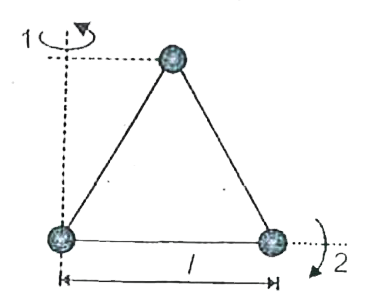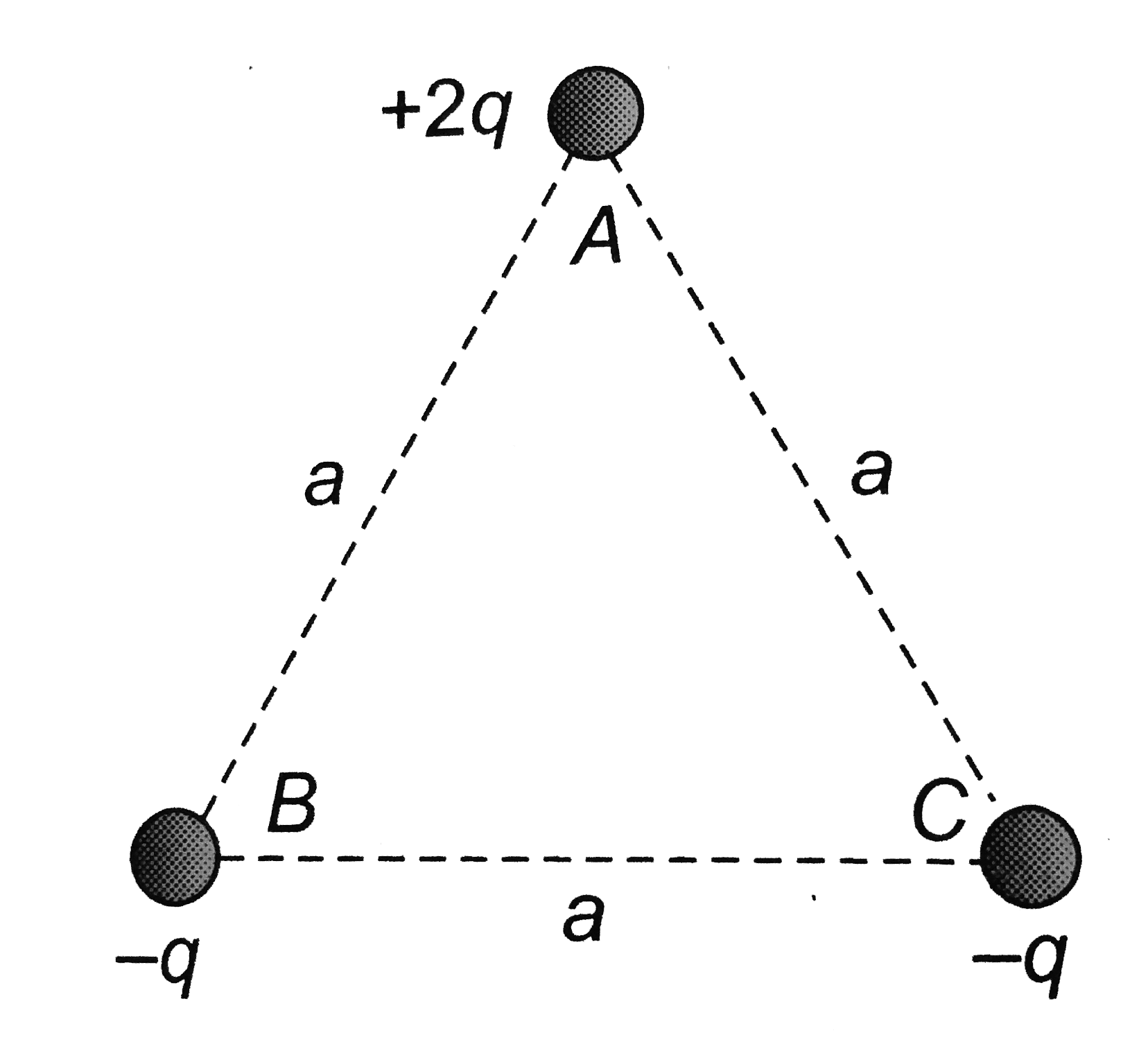Two charges of 4μC each are placed at the corners A and B of an equilaternal triangle of side length 0.2m in air. The
electric potential at C is [14πε0=9×109N−m2C2]
9×104V
18×104V
36×104V
36×10−4V
The correct Answer is:C
To find the electric potential at point C due to the two charges located at points A and B, we can follow these steps:
Step 1: Understand the Configuration
We have two charges, each of 4μC (microcoulombs), placed at the corners A and B of an equilateral triangle with side length 0.2m. We need to find the electric potential at point C, which is the third corner of the triangle.
Step 2: Formula for Electric Potential
The electric potential V due to a point charge Q at a distance r is given by:
V=14πϵ0⋅Qr
Where 14πϵ0=9×109N m2/C2.
Step 3: Calculate the Potential at Point C
Since both charges are equal and located at the same distance from point C, the total potential at point C due to both charges is the sum of the potentials due to each charge:
VC=VA+VB
Where VA and VB are the potentials due to charges at A and B respectively.
Step 4: Calculate Individual Potentials
The distance from each charge to point C is 0.2m (the side length of the triangle). Thus:
VA=VB=14πϵ0⋅Qr=9×109⋅4×10−60.2
Calculating VA and VB:
VA=VB=9×109⋅4×10−60.2=9×109⋅20×10−6=180×103V
Step 5: Total Potential at Point C
Since VC=VA+VB:
VC=180×103+180×103=360×103V=36×104V
Final Answer
The electric potential at point C is:
VC=36×104V
We have two charges, each of 4μC (microcoulombs), placed at the corners A and B of an equilateral triangle with side length 0.2m. We need to find the electric potential at point C, which is the third corner of the triangle.
The electric potential V due to a point charge Q at a distance r is given by:
V=14πϵ0⋅Qr
Where 14πϵ0=9×109N m2/C2.
Since both charges are equal and located at the same distance from point C, the total potential at point C due to both charges is the sum of the potentials due to each charge:
VC=VA+VB
Where VA and VB are the potentials due to charges at A and B respectively.
The distance from each charge to point C is 0.2m (the side length of the triangle). Thus:
VA=VB=14πϵ0⋅Qr=9×109⋅4×10−60.2
Calculating VA and VB:
VA=VB=9×109⋅4×10−60.2=9×109⋅20×10−6=180×103V
Since VC=VA+VB:
VC=180×103+180×103=360×103V=36×104V
The electric potential at point C is:
VC=36×104V
Topper's Solved these Questions
- ELECTROSTATIC POTENTIAL AND CAPACITORSBOOK - DC PANDEY ENGLISHCHAPTER - ELECTROSTATIC POTENTIAL AND CAPACITORSEXERCISE - Check point 2.2
15 Videos
- ELECTROSTATIC POTENTIAL AND CAPACITORSBOOK - DC PANDEY ENGLISHCHAPTER - ELECTROSTATIC POTENTIAL AND CAPACITORSEXERCISE - Check point 2.3
15 Videos
- ELECTROSTATIC POTENTIAL AND CAPACITORSBOOK - DC PANDEY ENGLISHCHAPTER - ELECTROSTATIC POTENTIAL AND CAPACITORSEXERCISE - (C) Chapter exercises
50 Videos
- ELECTROMAGNETIC WAVESBOOK - DC PANDEY ENGLISHCHAPTER - ELECTROMAGNETIC WAVESEXERCISE - Sec C
22 Videos
- ELECTROSTATICSBOOK - DC PANDEY ENGLISHCHAPTER - ELECTROSTATICSEXERCISE - Medical entrances gallery
37 Videos
Similar Questions
Three particles, each having a charge of 10μC are placed at the coners of an equilateral triangle of side 10cm. The electrostatic potential energy of the system is (Given 14πε0=9×109N−m2/C2)
View SolutionEqual charges q are placed at the vertices A and B of an equilatral triangle ABC of side a. The magnitude of electric field at the point C is
View Solution
Knowledge Check
Electric charges q,q,–2q are placed at the corners of an equilateral triangle ABC of side l. The magnitude of electric dipole moment of the system is
AqlB√3qlCzeroD4ql
Electric charges q,q,–2q are placed at the corners of an equilateral triangle ABC of side l. The magnitude of electric dipole moment of the system is
View SolutionThree charges 2 μC , -4 μC and 8 μC are places at the three vertices of an equilateral triangle of side 10 cm. The potential at the centre of triangle is
View SolutionThree point charges of +2q,+2qand−4q are placed at the corners A, B and C of an equilateral triangle ABC of side x. The magnitude of the electric dipole moment of this system is ?
View SolutionThree particle each of mass m are placed at the corners of equilateral triangle of side l

Which of the following is/are correct ?
View SolutionThree equal charges, each +q are placed on the corners of an equilatreal triangel . The electric field intensity at the centroid of the triangle is
View SolutionCharges 5μC,−2μC,3μCand−9μC are placed at the corners A,B,C and D of a square ABCD of side 1m. The net electric potential at the centre of th square is
View SolutionThree charges of (+2q),(−q) and (−q) are placed at the corners A,B and C of an equilateral triangle of side a as shown in the adjoining figure. Then the dipole moment of this combination is

View Solution
